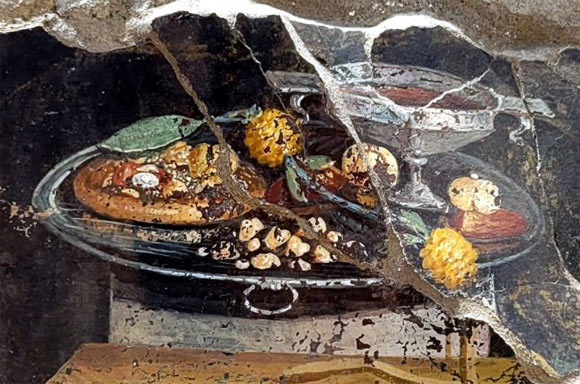A 2,000-year-old still life fresco depicting a flat focaccia (Italian flatbread) has been found among the ruins of Pompeii, an ancient Roman city frozen in time after the catastrophic eruption of Mount Vesuvius in 79 CE.

The 2,000-year-old fresco in Pompeii showing what may be an ancestor of modern pizza. Image credit: Pompeii archeological park.
The 2,000-year-old still life fresco was discovered during excavations in the Regio IX area of the Pompeii archeological park, near Naples, Italy.
The fresco appears to depict a focaccia, a cup of wine, various fruits and what looks like moretum (Roman herb-and-cheese spread).
“Whilst it looks like a pizza, this image from a Pompeian painting from 2,000 years ago obviously can’t be, since some of the most characteristic ingredients are missing, namely tomatoes and mozzarella,” said archaeologists with the Archaeological Park of Pompeii.
“However, as shown by a first iconographic analysis of the fresco, which emerged recently as part of the new excavations in the inula 10 of the Regio IX in Pompeii, what was represented on the wall of an ancient Pompeian house could be a distant ancestor of the modern dish.”

The 2,000-year-old still life fresco on the wall of a house in Pompeii. Image credit: Pompeii archeological park.
“It is possible to suppose that next to a wine cup placed on a silver tray, there is depicted a flat focaccia that functions as a support for various fruits (likely a pomegranate and dates), with spices and perhaps with a type of pesto (moretum in Latin) as indicated by yellow and ochre dots, possibly condiments,” they added.
“Moreover, on the same tray, dried fruits and a garland of yellow strawberry trees are present next to the dates and a pomegranate.”
“Pompeii never ceases to amaze. It is a chest that always reveals new treasures,” said Italian culture minister Gennaro Sangiuliano.
“Beyond the precise identification of the represented foods, we find in these frescoes the Hellenistic tradition, elaborated on by authors from the Roman Imperial Age, such as Virgil, Martial and Philostratus,” said Gabriel Zuchtriegel, director of Pompeii archaeological park.
“I think about the contrast between a modest and simple meal that reminds us of a sphere that stands between the pastoral and the sacred on one side, and the luxury of the silver trays and the refinement of the artistic and literary representations on the opposite side.”
“When considering this matter, how can we not think about pizza, also born as a ‘poor’ dish in southern Italy that has now conquered the world and is served in Michelin star restaurants.”







